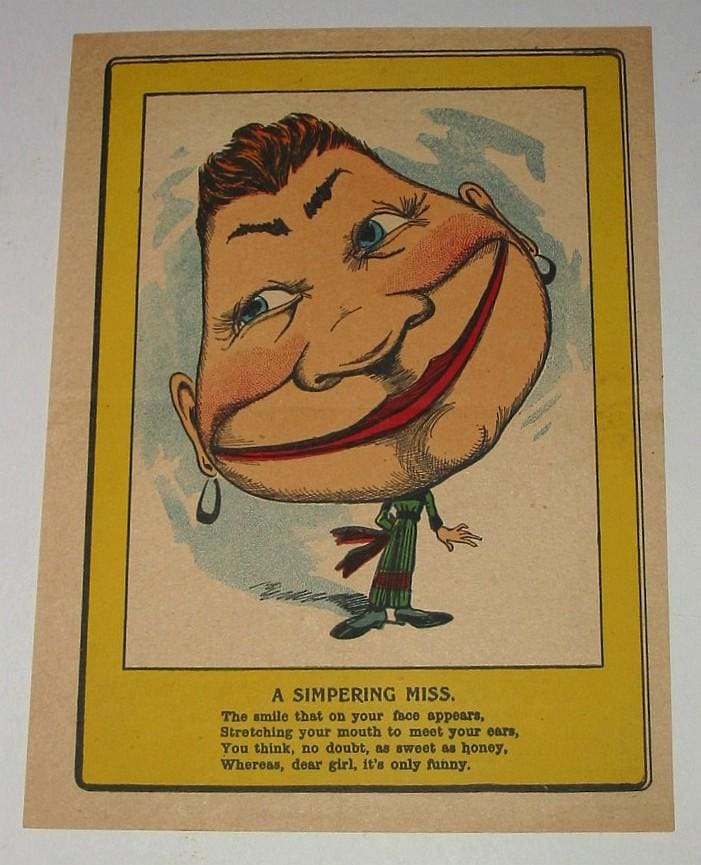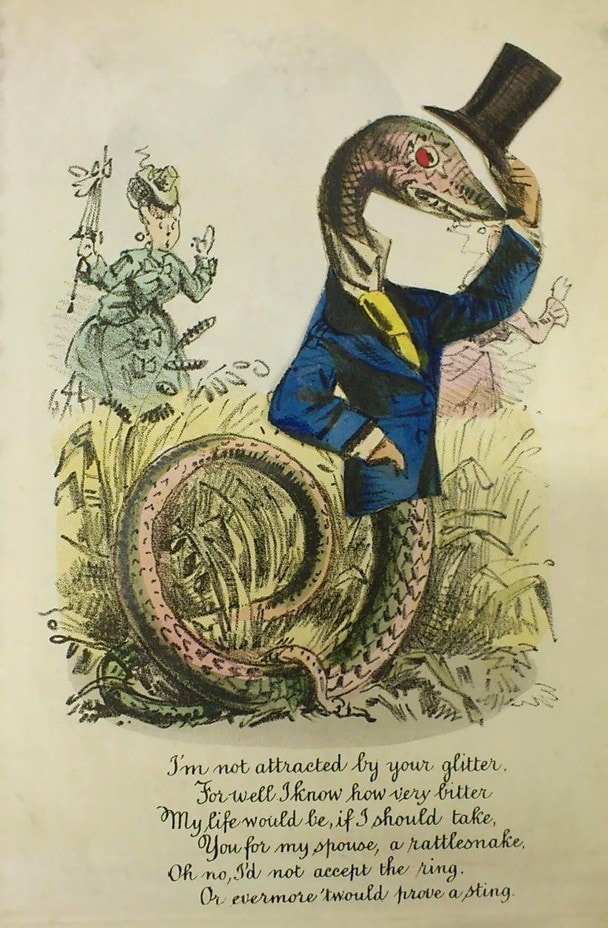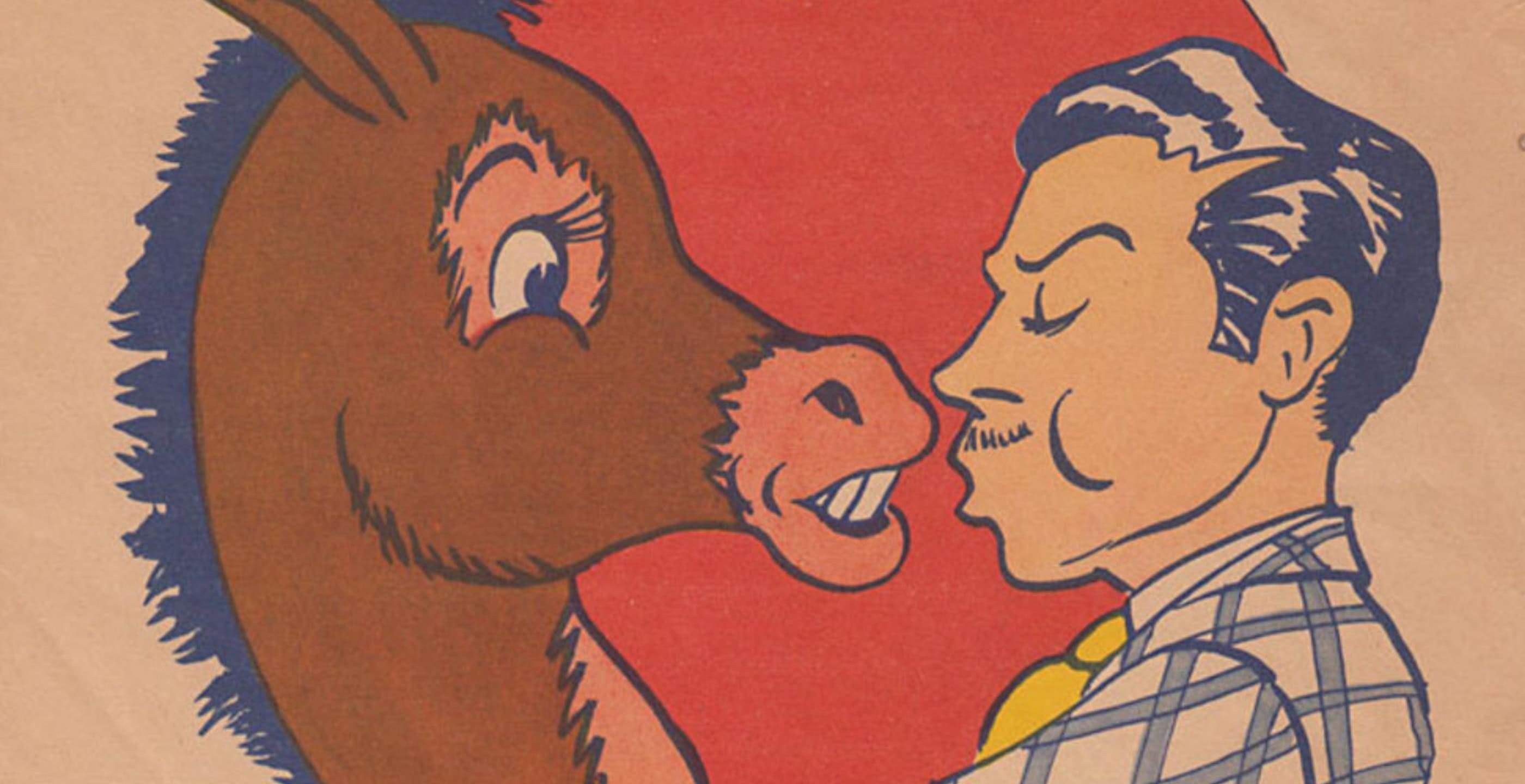It’s always tricky negotiating St Valentine’s Day etiquette. Take, for example, a recent cartoon showing an irate recipient of flowers, chocs and a giant Valentine’s Day card berating her boyfriend because she was on a new diet, allergic to flowers and the card wasn’t produced sustainably. One could argue that a celebration of lurve based on the beheading of a Roman soldier was always going to be problematic…
El Paso Zoo’s recent answer to this was to embrace the darker side of the day with an offer to the public to name the zoo’s cockroaches after their ex’s, before watching them being fed to a meerkat live on Facebook. It’s a long way from the “Roses are red, violets are blue” greetings card cliché, and it seems a bit harsh on the poor cockroaches, who are nothing more than innocent bystanders in all of this. However, there’s nothing new about the “My Nasty Valentine” theme; and it all began in the 1840s, with the rise of the Vinegar Valentine card.
The perfect antidote to the lace and hearts “Be my Valentine” greeting, the Vinegar Valentine raised insult to an art form. Its victims were reduced to caricatures, including the old maid, the drunk, the scolding wife, the hen-pecked husband and a host of others reflecting the social attitudes of the day. The cards were popular in both Britain and the USA for over a century, although the two nations developed distinct themes and styles of card.

Above: A Vinegar Valentine from the early 1900’s
The cards were inexpensive and accessible to all classes, eventually becoming particularly popular with working class people when schooling and literacy rates were on the rise. At one point, sales of Vinegar Valentines matched those of conventional cards. To add insult to injury, in the USA letters could still be sent “collect”, which meant the recipient had to pay the cost of postage. In Britain, Rowland Hill’s reforms and the arrival of the Penny Black meant that the victims of the jibes no longer had to pay for the privilege of being insulted.
How insulting were the cards? It has to be said that they appear mild in comparison with the average Twitterstorm on a quiet news day. Here’s an example of one from Britain:
“You’re as vulgar a cad as I’d wish to meet,
And yet you’re devoured by pride and conceit,
But I fancy before very long you’ll find out,
That everyone thinks you an ignorant lout.”
Another one tells the recipient that he’s too much in love with the booze to find himself a girlfriend:
“The kiss of the bottle is your heart’s delight,
And fuddled you reel home to bed every night,
What care you for damsels, no matter how fair?
Apart from your liquor, you’ve no love to spare.”
Of course, the point is that these were sent anonymously, thereby creating the potential for some five-star misunderstandings, not to mention arguments and even fights. If found out, the sender could claim that it was in fact a comic valentine, with humour rather than malice intended. However, it would be undeniably hard to brush off the lines “I’m not attracted by your glitter/ For well I know how very bitter/ My life would be, if I should take/ You for my spouse, a rattlesnake” as playful repartee. If the recipient was still in doubt about the sender’s feelings, the accompanying cartoon of a smarmy-looking snake in a suit should have driven home the message with the subtlety of a flying mallet.
In fact, brushing-off unwanted suitors appears to have been one of the principal uses of these vitriolic cards. Why say “No, thank you, I’m not interested,” when you can express it in a four-line poem with all the appeal of a stink-bomb encased in exploding glitter? So much easier and less irritating than having to say it face to face. At the cost of a penny a card and a penny to post it, revenge was both sweet and cheap.

Above: A Vinegar Valentine from the 1870’s
It wasn’t quite that simple, though. Some post offices found the messages sufficiently offensive that they refused to deliver them. Presumably there was a corner of the post office allocated to keeping them corralled, possibly with some “Warning! Toxic!” signs backed up with a skull and crossbones or two. Perhaps they were doing the sender a favour as well as the recipient. Popping a Vinegar Valentine in the post may have resulted in the same type of delayed guilt that arises from hitting the “send” button for the email that seemed like such a good idea at the time.
Vinegar Valentines and the Suffragettes
As women who were seen to be denying the role that society deemed fit for them, that is, marriage and the home, suffragettes came in for particular censure as the subjects of Vinegar Valentines. One of them shows a tall suffragette pressing down on a top-hatted Cupid as she crushes him towards the ground. The somewhat sinister verse reads:
“You may think it fun poor Cupid to snub,
With the hand of a Suffragette.
But he’s cunning and smart, aye, there’s the rub,
Revenge is the trap he will set.”
In fact, businesswomen, fashionable women, educated women, “girl athletes” and even those who were just “readers of books” came in for similar abuse. However, so too did policemen, actors, singers and country hicks who fancied themselves as lovers. All was grist to the mill when it came to Vinegar Valentines.
If you didn’t receive your expected quota of love missives this Valentine’s Day, at least with luck you’ll have avoided the malicious version. Haters gonna hate, as the saying goes, and there will always be sourpusses who prefer to send Valentine’s Day cards with enough vinegar to flavour a pair of fish suppers. No-one needs that; and, to coin another phrase, you can catch more flies with honey than vinegar. Or cockroaches, which can then be fed to a nearby meerkat should you feel so inclined, having named one of them after that ex, of course.
Miriam Bibby BA MPhil FSA Scot is a historian, Egyptologist and archaeologist with a special interest in equine history. Miriam has worked as a museum curator, university academic, editor and heritage management consultant. She is currently completing her PhD at the University of Glasgow.



